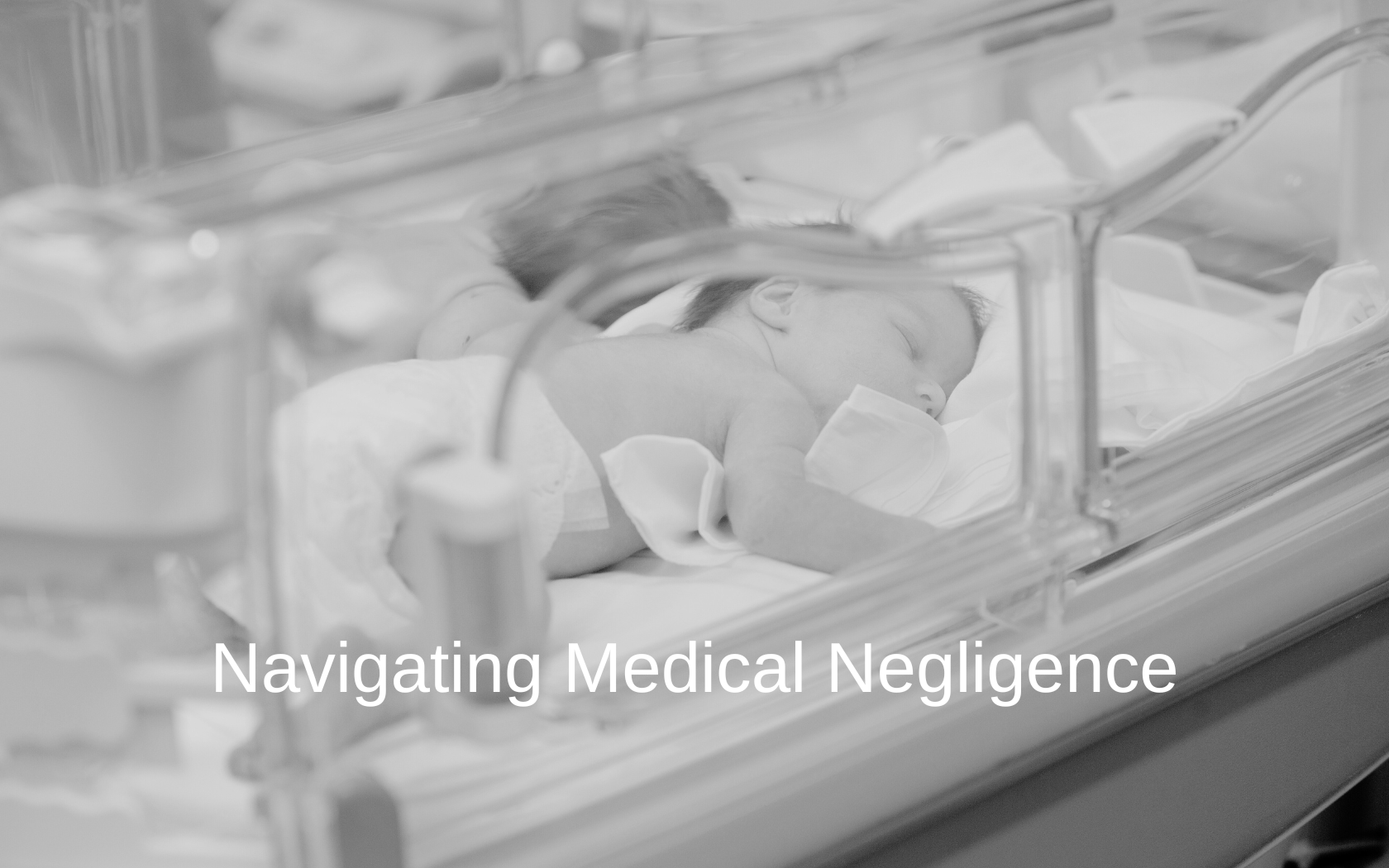Modern medicine has advanced so much that it’s less likely for a newborn to have HIE because of natural causes. But that doesn’t mean doctors no longer make mistakes. Unfortunately, the cause of a newborn’s HIE brain injury is often reckless or negligent medical care.
When that happens, someone is at fault for your child’s injury. But exactly whose fault is it? And how can you hold them liable?
In this article, we’ll provide general information that could shed some light on who could be liable when a child has HIE. If you’d like information and legal advice for your child, we invite you to schedule a free consultation with our lawyers.

What is an HIE Brain Injury?
First, it’s important to understand what an HIE brain injury is, and how it might happen. HIE stands for Hypoxic-Ischemic Encephalopathy. It helps to break this term down into its components:
- Hypoxic means a situation where the brain is deprived of an adequate oxygen supply.
- Ischemic refers to a restriction in blood supply to tissues. (This deprives them of oxygen and nutrients.)
- Encephalopathy is a broad term that refers to any abnormality or dysfunction of the brain.
Essentially, HIE is a condition stemming from a decreased supply of oxygen and blood flow to the brain.
This lack of oxygen and blood flow can result in damage to brain tissue. can have significant consequences, including developmental delays, cognitive impairments, motor deficits, and in severe cases, even death.
How Does an HIE Occur in Babies?
Most HIE brain injuries occur during childbirth. They come from complications that interrupt the baby’s oxygen supply. Some examples of these complications include:
- Prolonged labor: when labor lasts longer than it should.
- Umbilical cord issues: such as when the umbilical cord gets compressed or slips into the birth canal ahead of the baby.
- Placental abruption: When the placenta separates from the uterine wall before delivery. This reduces oxygen and nutrient supply to the baby.
- Uterine rupture: When the uterus tears during labor, causing blood loss for both mother and baby. This could lead to oxygen deprivation for the baby.
- Maternal Hypotension: A significant drop in the mother’s blood pressure during labor. It can reduce blood flow to the placenta.
- Infections: Maternal infections, such as chorioamnionitis (infection of the fetal membranes), can lead to inflammation and compromise blood flow to the baby.
- Fetal distress: Signs of fetal distress during labor, such as abnormal heart rate patterns (fetal bradycardia or tachycardia), may indicate reduced oxygen supply to the baby.
How Negligence Can Lead to an HIE Brain Injury
Experiencing complications like the ones above doesn’t automatically mean a baby will have an HIE brain injury.
But they do increase the risk of having one, especially if the medical team doesn’t respond to address them right away. Early recognition and intervention are critical in minimizing the risk of HIE.
Sometimes the medical team drops the ball when it comes to responding to handling a birth or responding to complications. Errors that may constitute negligence include:
- Failing to monitor fetal distress
- Delayed response when fetal distress is detected
- Inadequate management of maternal health conditions
- Errors during assisted delivery
- Failing to perform a C-section on time, or at all
- Misusing labor-inducing drugs
- Inadequate prenatal care

Who Could Be Liable for an HIE Brain Injury?
Sarah’s pregnancy had been relatively smooth, but as she went into labor, complications arose. The fetal heart monitor showed irregularities indicating fetal distress. However, the attending nurse failed to recognize the signs. Despite Sarah’s repeated concerns, the nurse assured her everything was fine. By the time the doctor was called in, it was too late. Sarah’s baby was born with HIE due to prolonged oxygen deprivation during labor, leaving her with lifelong challenges.
In Sarah’s case, it’s obvious that the attending nurse made a mistake. But she might not be the only one liable for the baby’s injury. Perhaps the hospital didn’t properly train that nurse, or knew she didn’t have the right qualifications but hired her anyway. Maybe the doctor didn’t treat Sarah’s baby’s injuries right away, making the injury more severe.
Families who sue for an HIE brain injury may be able to name more than one person as responsible in a lawsuit. Those they could potentially hold liable include:
- The hospital
- Nursing staff
- Doctors
- Anesthesiologists
- Other hospital staff
Let’s take a look at another example. David’s mother had a history of gestational diabetes, which was inadequately managed throughout her pregnancy. During labor, the medical team failed to consider this crucial information, leading to complications. David was born with macrosomia (large birth weight), which further complicated delivery. The resulting prolonged labor led to oxygen deprivation, causing HIE. The negligence in managing his mother’s condition and overlooking her medical history contributed to David’s lifelong struggles.
Oftentimes, a combination of adverse events and choices leads to HIE. It can be difficult to pinpoint exactly who’s responsible. This is why you’ll need the help of a birth injury lawyer, should you decide to file a lawsuit.
Birth injury attorneys have ample knowledge about birth negligence. They may not have studied medicine themselves, but they have access to medical experts who can shed light on what went wrong and who’s to blame.
Potential Long-term Complications of HIE
The reason why HIE can be such a catastrophic condition is because it can damage a baby’s developing brain. A lack of oxygen can prevent or stunt normal growth. It can cause lesions that lead to lifelong neurological issues. Many children with HIE brain injuries have permanent disabilities and conditions like cerebral palsy.
Here are some of the most common conditions that can stem from an HIE brain injury:
- Intellectual disabilities
- Developmental delays
- Visual or Hearing impairments
- Cerebral Palsy
- Social and adaptive functioning challenges
- Paralysis and other neurological deficits
- Speech and language disorders
- Behavioral and emotional disorders
These disabilities may be permanent and require lifelong treatment. So it’s no wonder that the cost of caring for a child with an HIE brain injury can soar to staggering heights.
When HIE results from negligence, the liable party (or their insurance company) should take responsibility for those costs. More often than not, the only way to get them to do so is through filing a HIE brain injury lawsuit.

We Can Help You Determine Who Caused Your Baby’s HIE Brain Injury
Coping with an HIE brain injury is difficult enough. Dealing with a lawsuit on top of that can make life even more stressful. But you don’t have to “play detective” yourself to try to pin down who caused your child’s injury. You can leave that to a competent birth injury lawyer.
For a complimentary consultation, reach out to our award-winning attorneys here. If we accept your case, we’ll begin a thorough investigation to discover whether negligence caused your child’s injury and determine who is responsible.
There are no upfront costs associated with this investigation. We work on a contingency fee basis. That means our fees are contingent upon the outcome of your case. If we recover compensation, our fee will be a percentage of the settlement or court award. If you receive nothing, neither do we. To learn more, give us a call or fill out our brief contact form.
Newborn HIE Brain Injury FAQ’s
The life expectancy for a baby with a hypoxic brain injury can vary from a few hours to a normal lifespan. Most infants with mild and moderate HIE survive to adulthood. Those with moderate HIE may have lifelong effects from this condition. But those conditions might not affect lifespan. The factors that influence how long a baby with HIE will live include:
– The severity of the injury
– The extent of brain damage
– The effectiveness of medical treatment
– How early the baby was treated
– The baby’s overall health condition.
Yes, many babies with HIE make a full recovery. With proper treatment, they can reach developmental milestones similar to their peers. Some don’t have any long-term issues. However, babies with severe HIE tend to have long-term neurological disabilities. Many develop cerebral palsy. Others have epilepsy.
The good news is that more babies are recovering fully from HIE than ever before, thanks to advances in medical care. For those who can’t make a full recovery, therapeutic interventions, and ongoing support can provide a better quality of life.
HIE primarily affects the brain. However, oxygen deprivation and decreased blood flow can affect any organs. For example, it can lead to respiratory distress and compromise lung function. Reduced oxygen levels can impair liver function, leading to liver damage and dysfunction. Kidneys may also suffer—some babies with HIE end up with acute kidney injuries. HIE can also affect the heart’s ability to pump blood efficiently.
Other organs that HIE could affect include but aren’t limited to the liver, intestines, spleen, pancreas, and adrenal glands.




